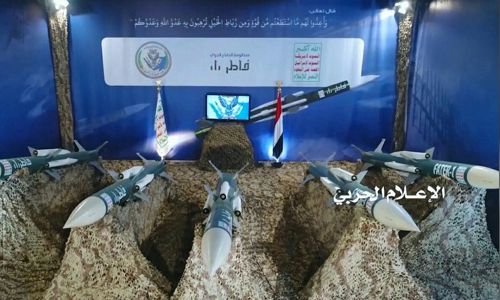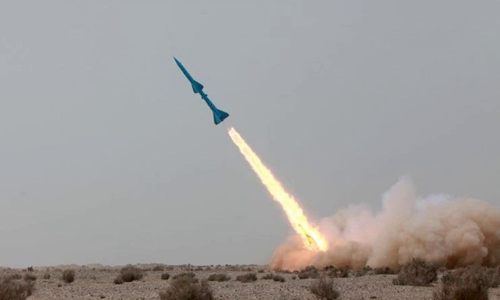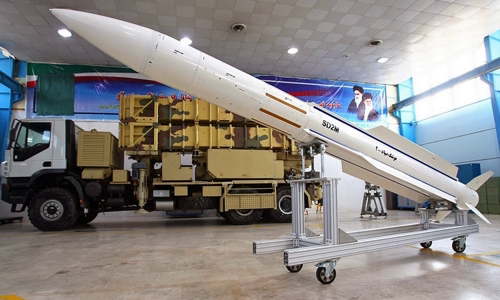Yemeni militants own a range of medium-range air defense missiles capable of shooting down Saudi-led coalition fighters.
The Al-Masirah page of Houthi rebels on February 16 released a video of the force shooting down Saudi Arabian Tornado IDS in Al-Jawf province, northern Yemen.

The Fater-1 rocket was launched by Houthi in mid-2019 Photo: Al-Masirah
Houthi rebel missiles shot down and attacked Saudi Arabia.
In the video, the Saudi pilot repeatedly dropped the heat trap to deceive the rocket, but failed when the bullet still crashed into the plane. Some experts suggest that this demonstrates missiles using radar guidance systems or radio control, making the heat trap useless.
Houthi forces did not say what type of weapon was used to shoot down Saudi strikes, but experts say the Yemeni militant group possesses medium-range air defense missiles that can threaten manned aircraft. coalition led by Riyadh.
According to aviation expert David Cenciotti, the most prominent in the Houthi rebellion's anti-aircraft armament is the Fater-1 missile made by this group, which looks identical to the 2S12 Kub complex launched by the Soviet Union in the past. 1960s.
Fater-1 was first launched in late August 2019 but has been in use since mid-2017, most likely a replica based on Kub systems in the Yemeni army since the 2015 conflict. US Central Command (CENTCOM) said an unmanned aerial vehicle (UAV) MQ-9 was shot down by the missile on June 6, 2019.
The Kub batteries consisted of a 1S91 radar and fire control vehicle capable of firing two missiles at the same time to one target, 4 launchers with 12 missiles and 4 loaders.
Kub's 3M9 shell has a maximum range of 24 km and shoots the target down at a height of 14 km, using radio guidance and semi-active radar when approaching the target. The rocket weighs 600 kg, of which the explosive warhead weighs 56 kg and reaches a maximum speed of 3,500 km / h. The ball carries the detonator and touches the target, allowing the target to be destroyed without direct contact.

Sayyad-1 rocket during an Iranian exercise Photo: Sepah News
Houthi militants also own variations of the Iranian-developed and transferred Sayyad medium-range anti-aircraft missiles, including the Sayyad-1 and Sayyad-2C models.
Sayyad-1 was developed by Iran after ordering the HQ-2 system, which is a copy of the Chinese-made S-75 series. The rocket uses the hull and engine design of the HQ-2 model, but is equipped with a leader and control unit based on a combination of MIM-23 Hawk and RIM-66 SM-1 that Iran bought from the United States before the Islamic Revolution. religion in 1979.
The Syyad-1 rocket can reach speeds of about 3,600 km / h, a range of 50 km and carries a detonator weighing 200 kg.
The Houthi force also appears to have a much more advanced Sayyad-2C variant, Cenciotti said. Iran does not disclose much information about this missile, but it uses a square-shaped launcher and storage tube cluster, each carrying four shells similar to the US MIM-104 Patriot system.
The Iranian military claims the Sayyad-2C missile can be combined with the S-200 long-range air defense complex to increase air defense.
The Sayyad-2C missile has a range of about 75 km, the shortest of all Iranian-made versions. It reaches a top speed of over 5,500 km / h, is equipped with an anti-jamming system, and carries a 200 kg explosive detonator. Tehran said Sayyad-2C can kill targets with very low radar reflexes like UAVs at altitudes up to 24 km.
Saudi coalition spokesman Turki al-Maliki said in late 2017 that the Houthi rebels had upgraded the R-27 and R-73 air-to-air missiles, which are used for fighter aircraft, into dangerous anti-aircraft weapons.

Sayyad-2 missiles and launchers launched by Iran in 2015 Photo: IRNA
Houthi captured these missiles from the Yemeni air arsenal when a major upheaval broke out in 2015. At that time, the Yemeni air force was operating MiG-29 fighters with the main weapon being an anti-aircraft missile. medium-range R-27 and short-range R-73. R-27 has a range of up to 70 km, while R-73 is capable of destroying targets from a distance of 30 km.
The R-27T and R-73 missiles are equipped with infrared probes, which help them track targets without the need for a guided radar. They also do not disturb the target during the approach, but can be deceived by heat trap on the aircraft.
These bullets are mounted on launchers on trucks, allowing for increased maneuverability. Rocket probes use power from their own generators, as the built-in battery only lasts a few minutes from activation, not suitable for anti-aircraft missile combat missions.
However, the Houthi rebels were unable to maintain the original range for the conversion missile. When launched from the ground, the bullet met great resistance and did not have the same high velocity as the aircraft, causing its range to be reduced by about half.
The Arab coalition said Houthi's missile had shot down at least one MQ-9 Reaper. The weapon was also used to attack F-16 fighters of the United Arab Emirates (UAE) and F-15 aircraft from Saudi Arabia, causing them to be damaged.
Yemeni militants are also equipped with a variety of shoulder-mounted anti-aircraft missiles, but they have a limited range and are just enough to threaten helicopters or low-flying UAVs, it is difficult to shoot down the fighters and activists operating in altitude above 5 km.



 AndrewSpringer
AndrewSpringer







